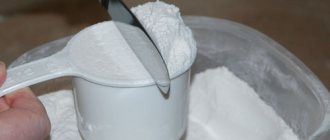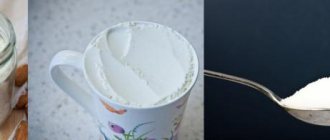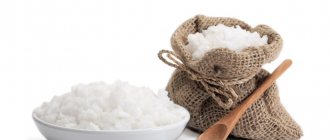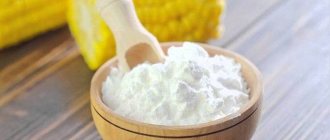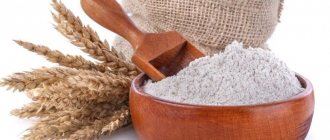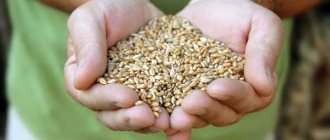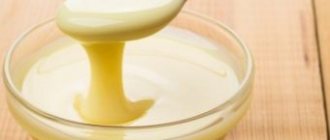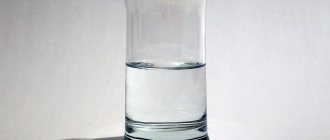When preparing food, sometimes you have to measure sugar by grams. Ideally, you should use scales, but in reality this is very inconvenient. Therefore, traditionally the weight of sugar is measured using spoons and glasses.
Our website already has a table with which you can approximately measure the weight of food in spoons and glasses. But the question often arises: “how to pour into a spoon: with or without ”, “into a glass: to the top or to the rim ”?
To resolve these questions, we simply took and weighed granulated sugar in a teaspoon and a tablespoon , as well as in a standard faceted glass. For clarity, we took photographs so that both the spoon and the pile of granulated sugar could be better seen. All images are “clickable” - a mouse click opens an enlarged copy of the image.
Weight of sugar in spoons and glasses
heaping teaspoon of sugar weighs 8–9 grams.
Sugar should be collected carefully to get the largest possible pile.
* Weight tables give the value: 10 g .
A teaspoon of sugar “ with a mound ” weighs 6–6.5 grams.
A heaping tablespoon of sugar weighs 22–24 grams.
To get a spoonful of sugar like this, you need to scoop it deep into the sugar bowl and carefully remove the spoon so as to get the largest possible pile.
* Weight tables show the value: 25 g .
heaped tablespoon of sugar weighs 13–14 grams.
To get this weight, you need to scoop up the sugar and shake off the excess sugar so that this spoon can be comfortably carried across the table at arm's length or from room to room without spilling a crumb.
A full faceted glass of sugar, filled to the brim, weighs 200 grams.
Granulated sugar should be collected level with the top edge of the glass: without a mound. To remove it, you can hold it over the glass with a knife or the handle of a tablespoon.
* Weight tables show the value: 200 g .
A faceted glass of sugar, filled exactly to the rim , weighs 160 grams.
This weight of sugar can be gained by scooping up 7 heaping tablespoons.
* Weight tables show the value: 160 g .
You can roughly measure any amount of sugar in a measuring cup. To do this, the required weight in grams is multiplied by 1.25 - the result is the required volume of sugar in milliliters. If, on the contrary, you need to convert sugar from milliliters to grams, then you need to multiply the volume by 0.8. We have summarized some correspondences between volume and weight in a table:
Sugar weight using measuring cup
| Volume | Weight |
| 50 ml | 40 g |
| 100 ml | 80 g |
| 125 ml | 100 g |
| 150 ml | 120 g |
| 200 ml | 160 g |
| 250 ml | 200 g |
| 500 ml | 400 g |
| 1 liter | 800 g |
* The article indicates the net weight of granulated sugar placed in a glass or spoon.
Lifehacks
Flour can be measured in any container, just know the volume of the container, and then we will tell you: 100 ml contains approximately 64 grams of flour, 150 - 96 g, 180 - 115 g, and 300 ml - 190 grams of flour. Then it's a matter of simple mathematics and a calculator.
Tip: when measuring products for cooking, if the order is not important, start with dry products: flour, cereals, sugar. If a certain amount of product remains on the walls of the container, later, when adding liquid ingredients, you will mix this amount into the dough - this way nothing will be wasted.
Enjoy cooking even without a scale! We hope this article will help you understand weights and measures, and there will be no more liquid pies due to a small amount of flour, or over-sweetened dishes.
Results
should be poured into a teaspoon or tablespoon possible , then its weight will correspond to the table (10 and 25 g). But our measurements showed that in reality, a teaspoon holds 1–2 grams less, and a tablespoon holds 2–3 g less. For most recipes, this difference is not important, but for a person it is only beneficial. Firstly, with numbers of 10 and 25 g it is much more convenient to count. Secondly, this way you will add and eat a little less sugar, and this will undoubtedly result in benefits for your health.
Three simple ways to determine the amount of sugar you need
1. Use scales, household or culinary. Their error is small; problems can only occur with a very small dosage. The only thing that prevents you from constantly using this method is the need to perform the same procedures every day every time you cook.
2. Purchase a special measuring cup at any hardware store. Measurements of the volume of various bulk products are printed on its outer side, and the problem of how to measure 150 grams of sugar will instantly disappear by itself.
3. You have neither scales nor measuring containers. Then let's turn to the most tried and tested technique of all periods and times - the use of ordinary cutlery as weight meters. In this case, it is advisable to allocate permanent dishes for these purposes, because... Both glasses and spoons are available in various shapes and capacities.
How many grams of sugar are in a teaspoon?
There are 7 heaped grams of sugar in a teaspoon.
1 teaspoon contains 5 grams of sugar without a slide
Calorie content of a spoon of sugar
For those who want to know how many calories are in a spoonful of sugar, first consider the total calorie content of granulated sugar and, based on this, calculate the exact value in one teaspoon and tablespoon.
Sugar calorie content 387 calories per 100 grams of product
The calorie content of a heaping tablespoon of sugar is 97 calories (without a heaping spoon, 77 calories).
The calorie content of a heaped teaspoon of sugar is 27 calories (without a heap of sugar, 19 calories).
Calorie content of sugar
It is very important to maintain accuracy, since sugar is a high-calorie product. There are 380 kilocalories in one hundred grams, that is, almost four in one gram. We often thoughtlessly add “a couple of spoons” to tea, not noticing that each of them contains from 16 to 20 calories, depending on whether the sweetener is heaped or not.
Lush curd balls in a frying pan without eggs
Curd balls are a very tasty and simple dessert that is usually enjoyed by both adults and children. Their s...
It’s easy to calculate that there are 95 kcal in a tablespoon. An average apple or several tangerines have the same energy capacity. And in a faceted glass there will be about 700 calories, depending on how you pour it. This is half the daily diet of an adult woman. So be careful when adding this sweetener to dough or desserts.
Measuring the right amount of product at home is easier than it seems at first glance. To do this, you only need dishes that are as close as possible to the standards. You can even get a special container: by measuring its volume once, you can always navigate in grams and measure out the amount of granulated sugar specified in the recipe without much difficulty.
How to measure sugar without scales using spoons
It is much more convenient to count large volumes of sugar using a glass (faceted), but not every home has one, so let’s look at the values of how to measure kilograms of sugar with a tablespoon:
- How to measure 3 kilograms of sugar without a scale with a spoon? 3 kg of sugar = 120 heaped tablespoons.
- How to measure 2 kilograms of sugar without a scale with a spoon? 2 kg of sugar = 2000 g of sugar = 80 heaped tablespoons of granulated sugar.
- How to measure 1.5 kilograms of sugar without a scale with a spoon? 1.5 kg of sugar = 1500 grams of sugar = 60 heaped tablespoons of sugar.
- How to measure 1 kilogram of sugar without a scale with a spoon? 1 kg of sugar = 1000 g of sugar = 40 heaped tablespoons of sugar.
- How to measure 900 grams of sugar without a scale with a spoon? 900 g sugar = 36 heaped tablespoons.
- How to measure 800 grams of sugar without a scale with a spoon? 800 g sugar = 32 heaped tablespoons.
- How to measure 750 grams of sugar without a scale with a spoon? 750 g sugar = 30 heaped tablespoons.
- How to measure 700 grams of sugar without a scale with a spoon? 700 g sugar = 28 heaped tablespoons.
- How to measure 600 grams of sugar without a scale with a spoon? 600 g sugar = 24 heaped tablespoons.
- How to measure 500 grams of sugar without a scale with a spoon? 500 g of sugar = 0.5 kg of sugar = 20 heaped tablespoons of sugar.
- How to measure 400 grams of sugar without a scale with a spoon? 400 g sugar = 16 heaped tablespoons.
- How to measure 350 grams of sugar without a scale with a spoon? 350 g sugar = 14 heaped tablespoons.
- How to measure 300 grams of sugar without a scale with a spoon? 300 g sugar = 12 heaped tablespoons.
- How to measure 250 grams of sugar without a scale with a spoon? 250 g sugar = 10 heaped tablespoons.
- How to measure 225 grams of sugar without a scale with a spoon? 225 g sugar = 9 heaped tablespoons.
- How to measure 200 grams of sugar without a scale with a spoon? 200 g sugar = 8 heaped tablespoons.
- How to measure 180 grams of sugar without a scale with a spoon? 180 g of sugar = 7 heaped tablespoons + 1 heaped teaspoon of sugar.
- How to measure 175 grams of sugar without a scale with a spoon? 175 g sugar = 7 heaped tablespoons of sugar.
- How to measure 150 grams of sugar without a scale with a spoon? 150 g sugar = 6 heaped tablespoons.
- How to measure 140 grams of sugar without a scale with a spoon? 140 g of sugar = 5 heaped tablespoons + 1 heaped dessert spoon of sugar = 5 heaped tablespoons + 3 level teaspoons of sugar.
- How to measure 130 grams of sugar without a scale with a spoon? 130 g of sugar = 5 heaped tablespoons of granulated sugar + 1 level teaspoon.
- How to measure 125 grams of sugar without a scale with a spoon? 125 g sugar = 5 heaped tablespoons.
- How to measure 120 grams of sugar without a scale with a spoon? 120 g of sugar = 4 heaped tablespoons + 1 heaped tablespoon of sugar.
- How to measure 110 grams of sugar without a scale with a spoon? 110 g of sugar = 4 heaped tablespoons of sugar + 2 heaped teaspoons.
- How to measure 100 grams of sugar without a scale with a spoon? 100 g sugar = 4 heaped tablespoons.
- How to measure 90 grams of sugar without a scale with a spoon? 90 g of sugar = 3 heaped tablespoons + 3 level teaspoons = 3 heaped tablespoons + 1 heaped dessert spoon.
- How to measure 80 grams of sugar without a scale with a spoon? 80 g of sugar = 3 heaped tablespoons of sugar + 1 level teaspoon.
- How to measure 75 grams of sugar without a scale with a spoon? 75 g sugar = 3 tablespoons.
- How to measure 70 grams of sugar without a scale with a spoon? 70 g sugar = 2 heaped tablespoons + 1 level tablespoon.
- How to measure 60 grams of sugar without a scale with a spoon? 60 g of sugar = 2 heaped tablespoons of sugar + 2 level teaspoons.
- How to measure 55 grams of sugar without a scale with a spoon? 55 g of sugar = 2 heaped tablespoons + 1 heaped teaspoon.
- How to measure 50 grams of sugar without a scale with a spoon? 50 g sugar = 2 heaped tablespoons of granulated sugar.
- How to measure 40 grams of sugar without a scale with a spoon? 40 g of sugar = 2 level tablespoons of sugar.
- How to measure 30 grams of sugar without a scale with a spoon? 30 g of sugar = 1 heaped tablespoon + 1 level teaspoon = 6 level teaspoons of sugar.
- How to measure 20 grams of sugar without a scale with a spoon? 20 g sugar = 1 level tablespoon = 4 level teaspoons.
- How to measure 15 grams of sugar without a scale with a spoon? 15 g of sugar = 1 heaped dessert spoon = 3 level teaspoons of sugar.
- How to measure 10 grams of sugar without a scale with a spoon? 10 g sugar = 1 level dessert spoon = 2 level teaspoons.
- How to measure 5 grams of sugar without a scale with a spoon? 5 g sugar = 1 level teaspoon of sugar.
Product weight table
When we find a new recipe for ourselves, on the Internet or a new cookbook, or perhaps a friend shared it, then first of all we pay attention to the products needed for cooking, and especially to their proportions.
Amounts of dry ingredients
(loose, solid products) are usually indicated in grams or measured in glasses, teaspoons or tablespoons. Well, everything is clear with grams. If you have a kitchen scale, then you probably know what to do.
If there are no scales, then we need to somehow convert our grams into glasses or spoons, based on how much of a particular product is required. It is more convenient to measure larger quantities in glasses. the table of product weights and measures will help us .
It will also be needed for reverse recalculation, when it is more convenient for us to measure all quantities using scales, rather than dirty glasses and spoons.
But, it is important to remember that in recipes adapted for Russia, a glass does not mean a measuring cup
(minimum volume - 300 ml), and regular
faceted
(volume up to the marks - 200 ml, up to the edges - 250 ml).
In this case, the glass must be filled exactly to the line where the edges end; it does not need to
be compacted.
The volume of a teaspoon
should be 5 ml, and
a tablespoon
should be 18 ml. We scoop dry products with a heaped spoon.
In foreign culinary literature, quantities are measured not in glasses, but in cups. But this doesn’t really change anything, since a cup is the same glass, filled to the brim - the same 250 ml. If you often come across recipes with “cups” instead of “glasses”, then you will find the following information useful.
Volume measures (America): Volume measures (England): Weight measures:
|
|
|
In this case, we use a measuring cup, or buy ourselves a special set of measuring spoons. Fortunately, these are on sale.
Quantities of liquid products
indicated either in ml or in glasses, spoons. Sometimes the value is indicated in grams.
If glasses are indicated - take a faceted glass, spoons are indicated - use them, milliliters are indicated - take a measuring cup, grams are indicated - use scales, or use the table to determine how many glasses or spoons are needed.
And again, the table of food weights comes to our aid. Liquid foods should fill spoons to the brim. Scoop viscous products with a heaped spoon.
If you don't have a cut glass in your kitchen, use a measuring glass. Look for the 200 and 250 ml marks. For clarity, they can be emphasized with a bright marker. If you need a cup of flour, add it to the bright line. Of course, if the required amount of flour is a multiple of 200 grams, then it is more convenient to use a measuring cup (flour scale).
At the same time, spoon the flour into the glass, rather than scoop it up. In the latter case, voids may form. It is more convenient to measure small amounts of flour with a tablespoon. A spoonful of flour is a heaped spoonful.
Flour should be sifted only after the amount required for the recipe has been measured, since sifted flour does not fit so tightly.
How to measure the right amount of product is up to you to decide. We hope our summary table will help you when preparing your meals. For your convenience, the products in the table are arranged in alphabetical order. Some foods are grouped (legumes, cereals, nuts, etc.). The table shows how many grams
the product is contained in a certain volume.
Product 1 tablespoon 1 teaspoon 1 glass, faceted 200 ml (to the rim) 1 tea glass 250 ml (to the rim)
| Jam | 45 | 20 | 270 | 330 | |
| Water | 18 | 5 | 200 | 250 | |
| LEGUMES: | Peas | 25 | 10 | 174 | 220 |
| Beans | 30 | 10 | 185 | 230 | |
| Lentils | 25 | 7 | 170 | 210 | |
| Dried mushrooms | 10 | 4 | |||
| Jam | 40 | 15 | – | – | |
| Baker's yeast | – | 5 years | – | – | |
| Gelatin (powdered) | 15 | 5 | – | – | |
| Raisin | 25 | – | 130 | 165 | |
| Cocoa powder | 15 | 5 | 130 | – | |
| Potato starch | 12 | 6 | 130 | 160 | |
| Natural ground coffee | 20 | 7 | 80 | 100 | |
| Cornflakes | 7 | 2 | 40 | 50 | |
| GREATS: | "Hercules" | 12 | 3 | 70 | 90 |
| Buckwheat (kernel) | 25 | 8 | 170 | 210 | |
| Corn | 20 | 6 | 145 | 180 | |
| Manna | 25 | 8 | 160 | 200 | |
| Oatmeal | 18 | 5 | 135 | 170 | |
| Rice | 25 | 8 | 185 | 230 | |
| Pearl barley | 25 | 8 | 185 | 230 | |
| Wheat | 20 | 6 | 145 | 180 | |
| Millet | 25 | 8 | 180 | 220 | |
| Sago | 20 | 6 | 145 | 180 | |
| Barley | 20 | 7 | 154 | 180 | |
| Liquor | 20 | 7 | – | – | |
| Citric acid (crystals) | 25 | 8 | – | – | |
| Poppy | 15 | 4 | 120 | 155 | |
| Mayonnaise, margarine (melted) | 15 | 4 | 180 | 230 | |
| Pasta | – | – | 190 | 230 | |
| Honey | 35 | 12 | 265 | 325 | |
| Vegetable oil | 17 | 5 | 180 | 225 | |
| Butter | 50 | 30 | – | – | |
| Ghee butter | 20 | 6 | 190 | 240 | |
| Honey (liquid) | 30 | 9 | 330 | 415 | |
| Milk, fermented baked milk, kefir, yogurt | 18 | 5 | 200 | 250 | |
| Condensed milk | 30 | 12 | 220 | 300 | |
| Powdered milk | 20 | 10 | 100 | 120 | |
| Semolina flour | 20 | 7 | 145 | 180 | |
| Corn flour | 30 | 10 | 130 | 160 | |
| Wheat flour, rye | 25 | 8 | 130 | 160 | |
| NUTS: | Peanuts, shelled | 25 | 8 | 140 | 175 |
| Walnuts (kernel) | 30 | 10 | 130 | 165 | |
| Cedar | 10 | 4 | 110 | 140 | |
| Almond (kernel) | 30 | 10 | 130 | 160 | |
| Crushed nuts | 20 | 7 | 90 | 120 | |
| Hazelnut (kernel) | 30 | 10 | 130 | 170 | |
| Cereals | 14 | 4 | 100 | 180 | |
| Wheat flakes | 9 | 2 | 50 | 60 | |
| Jam | 36 | 12 | – | – | |
| Curdled milk | 18 | 5 | 200 | 250 | |
| Sour cream 10% | 20 | 9 | 200 | 250 | |
| Sour cream 30% | 25 | 11 | 200 | 250 | |
| Melted lard | 20 | 8 | 200 | 240 | |
| Granulated sugar | 25 | 8 | 160 | 200 | |
| Powdered sugar | 25 | 10 | 140 | 190 | |
| Cream 20% | 18 | 5 | 200 | 250 | |
| Condensed cream with sugar | 30 | 13 | – | – | |
| Drinking soda | 28 | 12 | – | – | |
| Juices (fruit, vegetable) | 18 | 5 | 200 | 250 | |
| Salt | 15 | 5 | 260 | 325 | |
| SPICES: | Ground cloves | – | 3 | – | – |
| Whole cloves | – | 4 | – | – | |
| Mustard | – | 4 | – | – | |
| Dry mustard | – | 3 | – | – | |
| Ground ginger | – | 2 | – | – | |
| Ground cinnamon | 20 | 8 | – | – | |
| Allspice peas | – | 5 | – | – | |
| Ground allspice | – | 4.5 | – | – | |
| Ground black pepper | 12 | 5 | – | – | |
| Black peppercorns | – | 6 | – | – | |
| Ground crackers | 20 | 5 | 110 | 130 | |
| Dried fruits | – | – | – | 80 | |
| Cottage cheese, fatty, low-fat | 17 | 6 | – | – | |
| Dietary cottage cheese, soft | 20 | 7 | – | – | |
| Curd | 18 | 6 | – | – | |
| Tomato paste | 30 | 10 | – | – | |
| Tomato sauce | 25 | 80 | 180 | 220 | |
| Vinegar | 15 | 5 | 200 | 250 | |
| BERRIES: | Cowberry | – | – | 110 | 140 |
| Cherry | 30 | 5 | 130 | 165 | |
| Blueberry | – | – | 160 | 200 | |
| Blackberry | 40 | – | 150 | 190 | |
| Strawberry | 20 | – | 120 | 150 | |
| Cranberry | – | – | 110 | 140 | |
| Gooseberry | 40 | – | 160 | 210 | |
| Raspberries | 20 | – | 145 | 180 | |
| Red currants | 35 | – | 140 | 175 | |
| Black currant | 30 | – | 125 | 150 | |
| Cherries | 30 | – | 130 | 165 | |
| Blueberry | – | – | 160 | 200 | |
| Mulberry | 40 | – | 135 | 195 | |
| Dried rosehip | 20 | 6 | – | – | |
| Tea | 12-15 | 4 | – | – | |
| Egg powder | 25 | 10 | 80 | 100 |
Source: https://www.eda5.ru/poleznye_sovety/table_of_weights/

